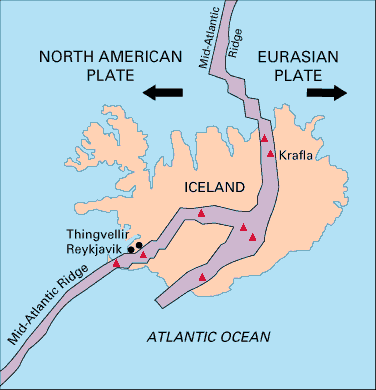What is a Divergent Boundary?
Divergent boundaries
Where divergent boundaries are located
A divergent boundary is an area where two crustal plates are separating. Most of these tectonic plate boundaries are located on the floor of the oceans. The separating plates form rift valleys on the ocean floor where there are weaknesses in the crust.
New oceanic crust
The weaknesses in the crust allow molten lava to move toward the Earth's surface on the ocean floors. The lava flowing out of vents on the ocean floor form the top of a long mountain range where the tectonic plates are separating.

Mid-Atlantic Ridge running through Iceland, USGS
Formation of the Global mid-ocean ridges
Global mid ocean ridge
The mountain range that the rift valley forms circles the Earth like seems on a baseball. In the upper mantle where the plates are separating molten rock forms in magma chambers. Molten lava oozes up out of the magma chambers onto the ocean floor creating pillow basalt.
New lava forms pillow basalt
Pillow basalt covers all the ocean floors. As new lava forms in the rift valley the tectonic plates continue to separate forming the global mid ocean ridge system that is the longest mountain range on Earth.


Click for More Information and to Order
Our magnetic poles
Magnetite points to magnetic north
Scientists have found the magnetite in basalt rocks recently erupted lines up with magnetic north , which is called normal polarity. They have found that in past eruptions the magnetite lined up with the south pole, which is called reverse polarity.
Sun's reversals of its magnetic poles
Just like clockworks every 11 years the Sun's magnetic poles reverse. Scientists have been documenting the reversals on the Sun for a number of years. The last time the poles switched was in late 2013.
Reversal of Earth's magnetic poles
The crystals in magnetite when it erupts onto the seafloor lines up at the present time with magnetic north. When the poles on Earth reverse the magnetite crystals in the rocks line up with magnetic south.
Past reversals on Earth
Magnetite in basalt rocks shows there have been many magnetic reversals in the past. The magnetite in the basalt rocks forms a zebra like pattern on the ocean floor. The magnetic reversals show the same stripes on both sides of the rift valley indicating the lava formed at the same time.
Iceland is unique
Iceland's divergent boundary
Iceland sits on a divergent boundary between the North American Plate and the Eurasian Plate that has formed the Atlantic Ocean. The Atlantic Ocean is increasing in size as the plates on either side of the Atlantic Ocean move apart.
Iceland's hot spot
The island sits over a hot spot. The frequent volcanic eruptions are a result of hot spot activity and separating plates. You can visit Iceland and stand in a rift valley similar to those found in ocean basins worldwide where the two plates are pulling apart.
Why is Iceland unique?
Iceland is unique because it is situated over a divergent boundary where plates are separating and a hot spot where magma from the upper mantle is feeding the volcanoes. The combination has built the island that rises above sea level.
KIDS FUN Science Bookstore
Check out Myrna Martin's award winning textbooks, e-books, videos and rock sets. The Kids Fun Science Bookstore covers a wide range of earth science topics. Click here to browse.










